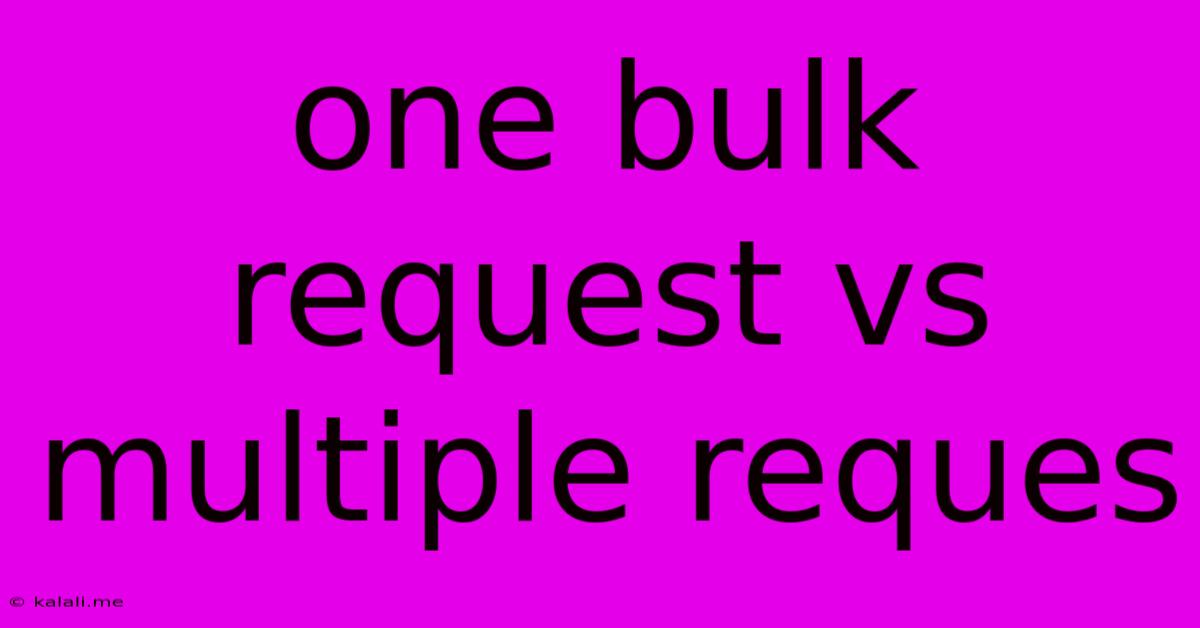One Bulk Request Vs Multiple Reques
Kalali
Jun 08, 2025 · 3 min read

Table of Contents
One Bulk Request vs. Multiple Requests: Optimizing Your API Strategy
Making requests to an API is a fundamental part of modern software development. Whether you're building a web application, a mobile app, or a backend service, you'll likely need to fetch data from or send data to external systems. A crucial decision in this process is whether to use a single bulk request or multiple individual requests. This article explores the trade-offs of each approach to help you choose the best strategy for your specific needs. The choice often hinges on factors like network latency, server load, and the complexity of your application.
Choosing the Right Approach: Bulk vs. Multiple Requests
The decision between using one bulk request versus multiple individual requests depends on several factors. Let's break down the pros and cons of each:
One Bulk Request:
Pros:
- Reduced Network Latency: Sending a single request significantly reduces the overhead associated with multiple round trips to the server. This is particularly beneficial when dealing with high latency connections, like mobile networks or international connections.
- Improved Efficiency: Fewer requests mean less processing on both the client and server sides, resulting in better overall performance and reduced resource consumption.
- Simplified Code: Managing a single request is generally simpler than coordinating multiple requests, leading to cleaner and more maintainable code.
- Better Batch Processing: Bulk requests are ideally suited for operations that can be batched together, such as creating or updating multiple records simultaneously.
Cons:
- Larger Payload Size: Bulk requests can lead to larger payloads, potentially exceeding size limits imposed by the server or network infrastructure.
- Increased Server Load (Potentially): While generally more efficient, a very large bulk request can still put a significant strain on the server, potentially impacting performance for other users.
- Error Handling Complexity: Handling errors in a bulk request can be more complex, as a single error might affect the entire batch. Proper error handling and retry mechanisms are crucial.
- Data Serialization Overhead: The process of combining data into a single request can add overhead, especially with large datasets.
Multiple Requests:
Pros:
- Smaller Payload Sizes: Individual requests inherently have smaller payloads, reducing the risk of exceeding size limits and improving error handling.
- Granular Error Handling: Handling errors is typically simpler with individual requests, as each request can be processed and handled independently. Failures in one request don't necessarily affect others.
- Flexibility: Multiple requests offer greater flexibility in how data is fetched and processed, enabling more dynamic and adaptive applications.
- Scalability: Distributing requests across multiple threads or processes can improve scalability and allow for parallel processing.
Cons:
- Increased Network Latency: The significant drawback is the increased network overhead due to multiple round trips to the server. This can negatively impact performance, especially on slower networks.
- Higher Resource Consumption: Managing multiple requests requires more client-side resources, potentially affecting application responsiveness and battery life on mobile devices.
- Increased Code Complexity: Coordinating and managing multiple requests generally leads to more complex code that can be harder to maintain.
- Potential for Rate Limiting: Making many individual requests increases the chances of hitting API rate limits, resulting in delays or errors.
Conclusion:
The optimal approach – one bulk request versus multiple requests – is context-dependent. Consider the size of your data, the network conditions, the server's capabilities, and the complexity of your application. For smaller datasets and faster networks, multiple requests might be sufficient. However, for larger datasets, slower networks, or applications requiring efficient batch processing, a single bulk request is often the better choice. Careful planning and performance testing are crucial for making the right decision. Always consider the potential trade-offs to optimize your application's efficiency and user experience.
Latest Posts
Latest Posts
-
Why Is My Xbox Downloading So Slow
Jun 08, 2025
-
Tracking Phases Of Design Process In A Ticketing Form
Jun 08, 2025
-
Free Backgrounds To Create Photshop Tags
Jun 08, 2025
-
Go Fast Alone Go Far Together
Jun 08, 2025
-
Thank You So So Very Much
Jun 08, 2025
Related Post
Thank you for visiting our website which covers about One Bulk Request Vs Multiple Reques . We hope the information provided has been useful to you. Feel free to contact us if you have any questions or need further assistance. See you next time and don't miss to bookmark.